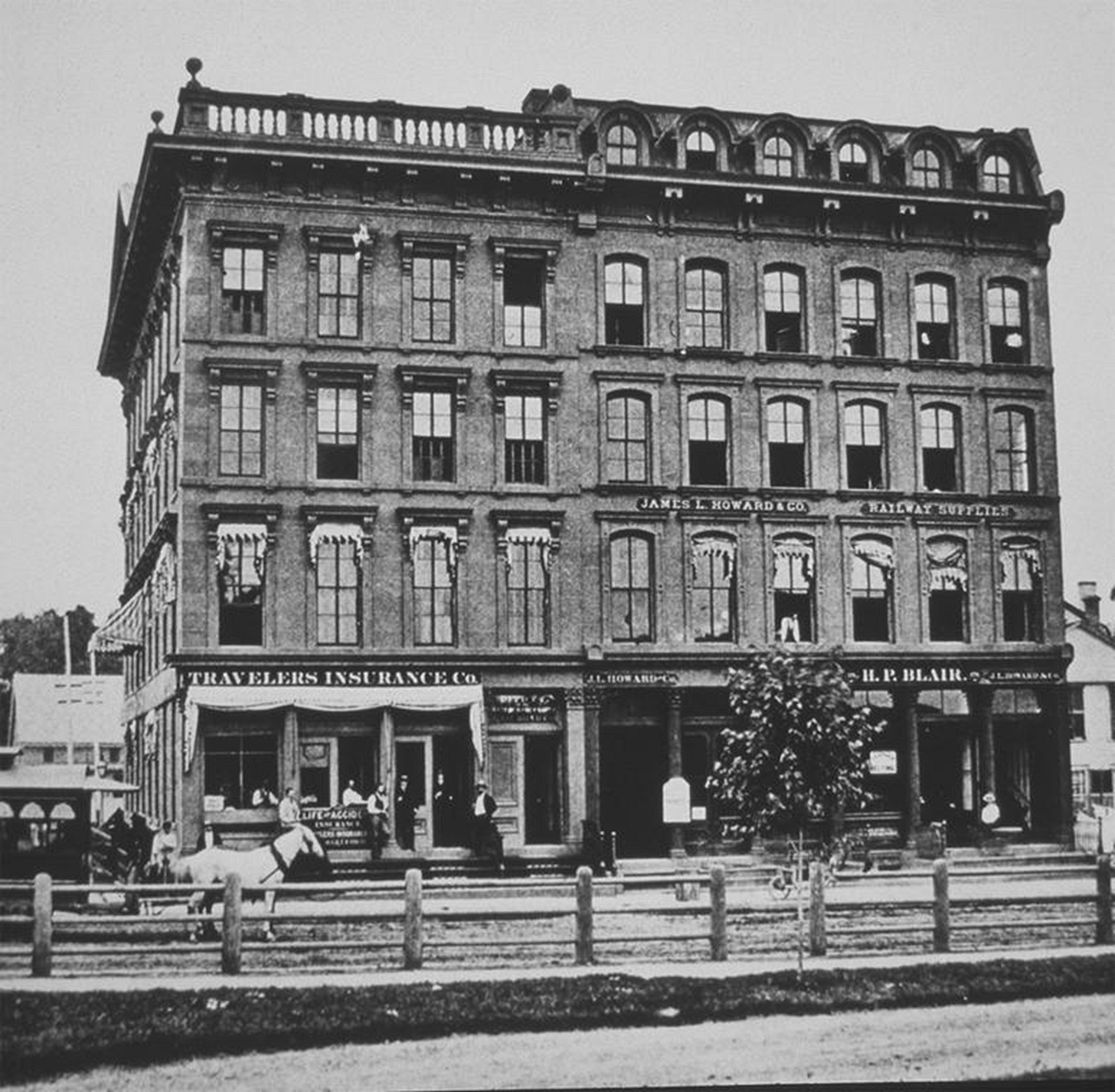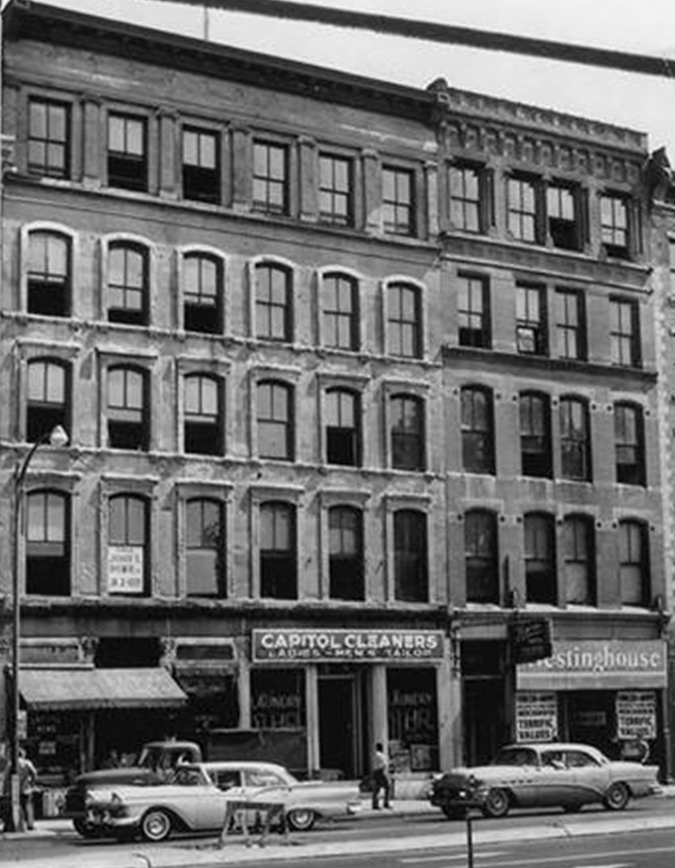
In my most recent video, which is about the history of the block of Asylum Street between Union Place and High Street, across from Bushnell Park, I mention a fire that swept through two buildings in 1899. One of them was a 4 & 1/2-story brick building owned James L. Howard, head of a company that produced hardware for the railroad industry and is still in business today in Bloomfield. It was erected in the 1870s next to an earlier brownstone building that Howard’s company had built in 1864-5 (at the same time the Hartford & New Haven Railroad was erecting their own building just next door to the west, at the corner of what’s now Union Place). Both Howard buildings were gutted in the 1899 fire.
The fire was described in the Hartford Courant on March 30, 1899:
It was after the fire in the Howard building on Asylum street had burned for twelve hours steadily until 2 o'clock yesterday afternoon that the last stream of water was shut off from the fire. All the early morning and during the day until nightfall, there was a large crowd of people watching what proved to be the most disastrous fire in Hartford for many yours. Nothing remains of the building but the brick walls, all the floors and the roof having been burned out, and the brownstone building next west was wrecked and burned out beyond repair, except by rebuilding. The building in the rear occupied by James L. Howard & Co. was completely burned out, and in addition to the loss of the tenants and the owners forty employees of the Howards are thrown out of employment.
The fire, which began about 2 o'clock yesterday morning, was stubborn and a hard one to fight, much headway having been made before it was discovered. It lighted up the whole north- west sky with the flames and made a brilliant spectacle for the crowd, which was very large for so early an hour in the morning. It did not take two hours to gut the building completely, and at 4 o'clock it was supposed that the fire would be confined to it alone, so far as any serious damage was concerned, but flames again broke out in the brownstone building west and before they could be got under control the roof and the two upper floors of that building had burned down and the other floors were wrecked.
Chief Eaton said of the fire that the fight was a difficult one because of a cross wall in the rear of Kingsley's store. This he did not know of, and in the dark and smoke the efforts were against this wall, in the vicinity of which he believes the fire started. The wall served as a guide to the flames, and they worked up and over it into all parts of the building with great rapidity. The firemen put in an immense amount of hard work and fought the new outbreak of the flames in the west building by a stream from a hose carried up the aerial truck, but they were unable to check it before the upper floors were in ruins. The fire as it worked into the grocery store caused an explosion and blew out the front glass of the windows. A stream, pouring in great quantities of water, was used with eight men at the hose. The stream was hard to handle and it got away from the men, throwing some of them down. Two of them were temporarily knocked out by bruises on the leg and in the groin. They were taken to the depot and Dr. E. K. Root examined their injuries, which he pronounced not serious. The men rallied after a while and returned to duty.
Besides J. L. Howard & Co., many other businesses leased space in these buildings. One was the A. D. Worthington & Co., one of the many subscription book publishers that flourished in Hartford in the nineteenth century. Focusing on biographies, memoirs, travel narratives, and histories, A. D. Worthington was notable for publishing many books by or about women. The publisher was badly affected by the fire:
A. D. Worthington, whose publishing house was on the second floor of the burned building was not insured. Loss in fixtures and such stook as he had in his office will not exceed $10,000. His beat books for the present market were at the printers being bound for the trade. Mr. Worthington said last evening that his greatest loss was his organization which filled the entire sides of a large room and contained ready reference to all the agents of the house. This was not insurable and was a total loss and his greatest loss. Systematic work of thirty years had made it invaluable. Mr. Worthington had shipped last week from the office two car loads of printed sheets and illustrations, enough for the making of 27,000 volumes, to Boston for binding. [. . .]
It is believed that all the tenants of the building are protected by insurance with the exception of Worthington & Co. A member of an insurance firm solicited Mr. Worthington to insure about ten days ago, but he said he wanted time to consider the matter. No sign of the establishment remains.
There was also a grocery store and a plumbing business in the brick building:
Kendrick C. Kingsley, the proprietor of the grocery store on the first floor of the building, had made an arrangement to sell his stuck and business to Penfield Giddings of Torrington. An Inventory was to have been taken Friday of this week and the transfer was to have been made Saturday, Mr. Giddings had his goods packed, a rent engaged and arrangements completed to begin business here.
There seems to be no doubt in the minds of those who have Investigated that the fire started in the store of Kingsley & Co., on the first floor in the brick building. [. . .]
The books of the firm of Andrews & Creedon, plumbers, were left on top of the desk over night and one of the firemen waded into the basement during the fire and got them.
The front wall of the Howard building was regarded as unsafe and the north walk of Asylum street has been roped off, and policemen put on guard to prevent persons from walking on that side of the street.
It was about 8:30 yesterday morning when the hose crossing the streets were rolled up and trolley cars were able to go out on the hill. Before that time all passengers were dropped off at High street, and those coming in were let off at the Asylum street bridge. There were no cars west of the blockade on the Asylum avenue or Ashley street lines. The great public walked.
Heins Brothers [who had a hotel next door to the burned buildings] provided the firemen with coffee and sandwiches.
The sound of the alarms was not generally heard, as they were rung at a time when people sleep most soundly and the tremendous rainfall made all the noise the wakeful could hear. The Courant's account brought the first knowledge to most of the citizens of Hartford and there was much commendation of so full a story of an event that occurred at a time when the paper is just being closed up.
Both burned buildings were soon rebuilt and each was enlarged by being raised an additional floor. The buildings were finally torn down in the late 1950s to make way for the Shoreham Motor Hotel, now the Capitol Hotel
.





